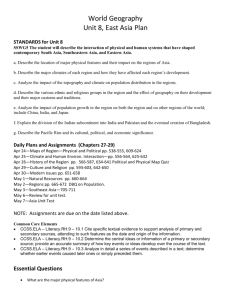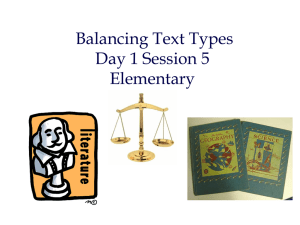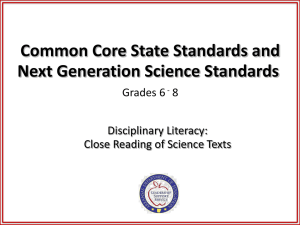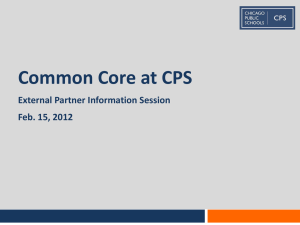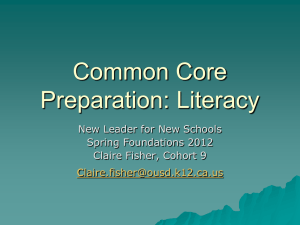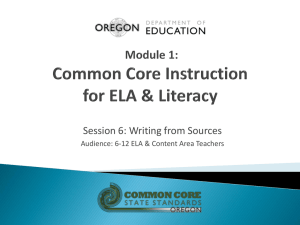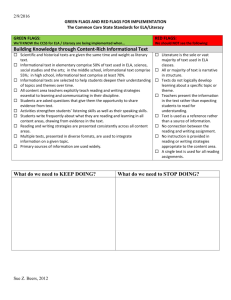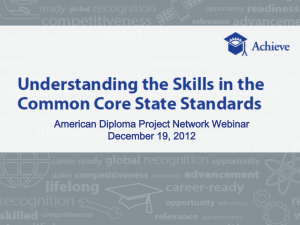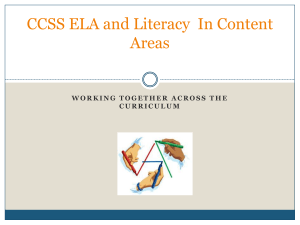The Common Core State Standards: Implications for Teaching
advertisement
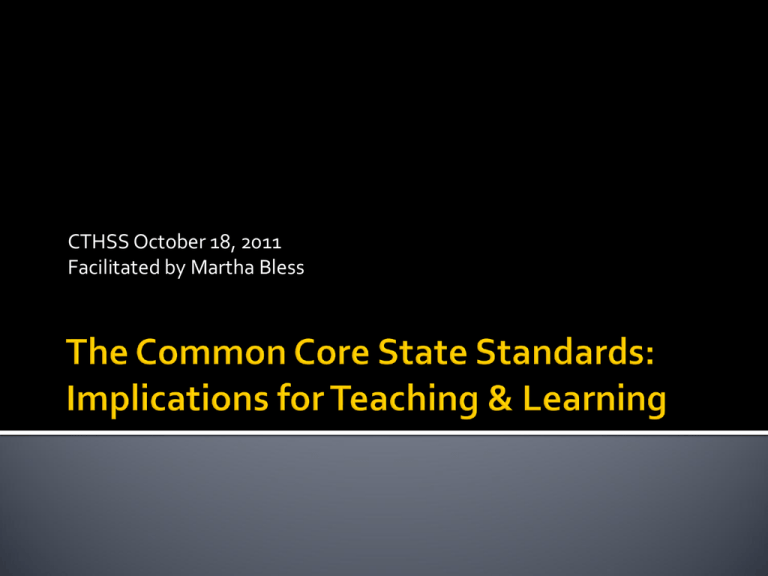
CTHSS October 18, 2011 Facilitated by Martha Bless Understand the connections among: SRBI CT Secondary School Reform The CCSS & CTHSS’s vision for literacy Review the evolution of the CCSS and the evolving definition of literacy Examine what’s new in the standards & state assessment Decide on next steps Tier 3: ~5% Tier 1: Comprehensive & Coordinated Instruction for All Students ~15% ~80% of Students Meet District Benchmarks with Instruction in Tier 1 Specialized, individualized Intervention for Students with intense needs Tier 2: Targeted Instruction for Students below grade level benchmark “All teachers …share the responsibility for teaching and supporting reading.” (CSDE Literacy/Language Arts Position Statement) “Research shows that teacher integration of literacy-related instructional strategies facilitates student learning across all content areas. It is through the literacy skills of reading, writing, listening, speaking, viewing and presenting that students acquire and retain content knowledge and content specific abilities” (Beyond the Blueprint. CSDE, 2007). Engagement 21st Century Skills Rigor Comprehensive, Critical Literacy Core content areas “Living and competing successfully in a global society and economy will require an understanding of our interconnectedness, collaboration and leadership skills, habits of personal and social responsibility, and adaptability to change.” “Likewise, …teachers are obligated to ensure that students have meaningful opportunities to integrate 21st Century Skills (e.g., technology, communication, collaboration, critical thinking, problem solving, innovation, creativity) and literacy skills within all content areas.” (CSDE Literacy/Language Arts Position Statement) Source: www.wikinomics.com Are “Digital Natives” “… are no longer the people our educational system was designed to teach” “… think and process information fundamentally differently from their predecessors” Require new skills & new literacies Are no longer just consumers – they are also producers and co-creators Source: Prensky, 2001. Individually Read “Evolving Definitions of Literacy” Pair up & discuss Note similarities & differences Which one(s) resonates with you? Why? Any that you disagree with? Given these definitions, what are the implications for teaching and learning? Share out Seven Survival Skills for Teens Today Critical thinking and problem solving Collaboration Adaptability Initiative and entrepreneurialism (Self-direction) Effective oral and written communication skills Accessing and analyzing information Curiosity and imagination Source: Wagner, T. (2008). The Global Achievement Gap. New York: Basic Evolution & Adoption http://www.corestandards.org Spring 2009, governors (National Governor's Association) and state commissioners of education (Council of Chief State School Officers) from 48 states, 2 territories & D.C. committed to developing a common core of state standards (CCSS) for K-12 English language arts (ELA) and mathematics Participating org’s: Achieve, Inc., ACT, College Board, Ntnl. Assc. of State BOE’s, Alliance for Excellent Education, Hunt Institute, Ntnl. PTA, State Higher Ed. Executive Officers, Am. Assc. of School Administrators, Business Roundtable, NEA, AFT, Ntnl. Councils of Teachers of English & Mathematics 44 states have adopted CCSS TX, WS, VA, NE , MT & AK have not These standards are not intended to be new names for old ways of doing business. It is time to recognize that standards are not just promises to our children, but promises we intend to keep. July 7, 2010: CCSS adopted by the CT State BOE CT content experts in English Language Arts and Mathematics conducted a “gap analysis” CCSS were compared to CT standards ▪ standard by standard at the same grade level ▪ pre-k-grade 12 80% of the CC ELA standards were matched to CT’s ELA standards 20% were not matched This translates to about 200 of the 1,019 CC ELA standards that will be “new” for CT English Language Arts Crosswalk Common Core State Standards to Connecticut State Standards CT Curriculum Design Unit Planning Organizer and sample units CCSS assume 100% mastery of the preceding year’s standards i. e., staircase not spiral Standards are high points, not finish lines Standards are not curriculum In order for change to be effective, it must be at the unit or chapter level Address both content and skills ELA content includes: classical myths, storied from around the world, America’s Founding Documents, foundational Am. Lit. & Shakespeare ▪ No required reading lists, just sample suggested texts ELA skills address: Reading & Writing; Speaking & Listening; Language; and Media & Technology Priority Standards Overarching standards for college and career readiness Supporting Standards More specific Aligned with District’s efforts to support and improve literacy Part of comprehensive District PD plan The CCSS are embedded into the new Language Arts Literacy Lab framework and curriculum documents 1. Literacy as part of science & social studies/history AND informational text as part of ELA Not teaching novels in science or history Teaching students how to read and interpret scientific & historical texts 2. Balance of literature & literary nonfiction 50/50 recommended ratio 3. Appropriately complex text Meant to increase rigor & address the gap between HS & college level text Emphasis on teaching academic vocabulary Recommendation from CCSS: ▪ Push more students to grapple with texts at their frustration level, and provide scaffolds to aid comprehension 4. Questions regarding text must be TEXTDEPENDENT 80% of questions should be text-dependent “Responses based on students’ background knowledge and the experiences they bring to school are not sufficient.” Video Example and discussion 5. Writing to INFORM or ARGUE using evidence “The ability to write logical arguments based on substantive claims, sound reasoning, and relevant evidence is a cornerstone of the writing standards…extending down into the earliest grades.” Personal narrative should be MINIMIZED Writing: Student Research “Short, focused research projects and longer term in depth research… is emphasized” 6. Media & Technology 21st century skills related to media use, both critical analysis and production of media, are integrated throughout State assessments will remain unchanged until 2014 CT is participating in the SMARTER Balanced Assessment Consortium (www.smarterbalance.org) charged with developing new assessments based on CCSS by 2015 Format: Moving away from “fixed-point” to a growth model Summative, Interim, and Formative for grades 38, and 11 Computer Adaptive Test (CAT) ▪ Not necessary to test all students at the same time Given these “6 shifts,” what are the implications for teaching and learning at your school? What can I do as a teacher to start integrating more nonfiction in my classroom? What could I do tomorrow? Teachers can: Collaborate with ELA, The District will: Continue the process of aligning curriculum and determining resource needs LMC, ELL, SPED & LA Lab colleagues to share lesson ideas & resources AND strategies for integrating technology & media literacy Collaborate with trades/tech teachers to access more informational texts martha.m.bless@gmail.com


